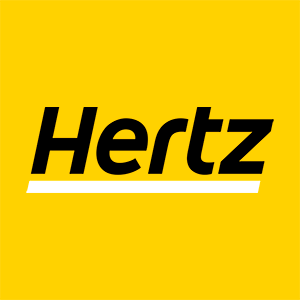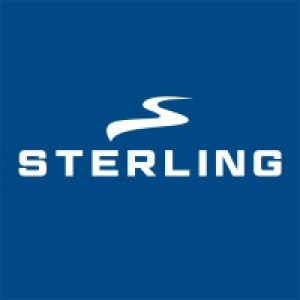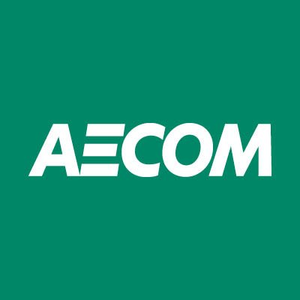
AECOM (ACM)
We’re skeptical of AECOM. Its underwhelming revenue growth and failure to generate meaningful free cash flow is a concerning trend.― StockStory Analyst Team
1. News
2. Summary
Why AECOM Is Not Exciting
Founded in 1990 when a group of engineers from five companies decided to merge, AECOM (NYSE:ACM) provides various infrastructure consulting services.
- Sales are projected to tank by 2.5% over the next 12 months as demand evaporates
- Backlog has dropped by 2.7% on average over the past two years, suggesting it’s losing orders as competition picks up
- A silver lining is that its earnings per share grew by 19.5% annually over the last five years, outpacing its peers


AECOM doesn’t check our boxes. There are more appealing investments to be made.
Why There Are Better Opportunities Than AECOM
Why There Are Better Opportunities Than AECOM
AECOM’s stock price of $102.45 implies a valuation ratio of 20x forward P/E. This multiple is cheaper than most industrials peers, but we think this is justified.
We’d rather pay up for companies with elite fundamentals than get a bargain on weak ones. Cheap stocks can be value traps, and as their performance deteriorates, they will stay cheap or get even cheaper.
3. AECOM (ACM) Research Report: Q3 CY2025 Update
Infrastructure consulting service company AECOM (NYSE:ACM) fell short of the markets revenue expectations in Q3 CY2025 as sales only rose 1.6% year on year to $4.18 billion. Its non-GAAP profit of $1.36 per share was 1.7% above analysts’ consensus estimates.
AECOM (ACM) Q3 CY2025 Highlights:
- The company will be holding its Analyst Day today, November 18, 2025
- Revenue: $4.18 billion vs analyst estimates of $4.32 billion (1.6% year-on-year growth, 3.3% miss)
- Adjusted EPS: $1.36 vs analyst estimates of $1.34 (1.7% beat)
- Adjusted EBITDA: $328.7 million vs analyst estimates of $324.9 million (7.9% margin, 1.2% beat)
- Adjusted EPS guidance for the upcoming financial year 2026 is $5.75 at the midpoint, in line with analyst estimates
- EBITDA guidance for the upcoming financial year 2026 is $1.29 billion at the midpoint, below analyst estimates of $1.29 billion
- Operating Margin: 5.7%, in line with the same quarter last year
- Free Cash Flow Margin: 3.2%, down from 6.7% in the same quarter last year
- Backlog: $24.83 billion at quarter end, up 4.1% year on year
- Market Capitalization: $17.47 billion
Company Overview
Founded in 1990 when a group of engineers from five companies decided to merge, AECOM (NYSE:ACM) provides various infrastructure consulting services.
The company provides advisory, planning, consulting, architectural, and engineering design services to public and private clients. Businesses and government organizations in industries like transportation, facilities, water management and go to AECOM for its consulting services.
The company offers its consulting services to five types of markets, which include transportation, like rail, highways, bridges, and ports; water, like drought response and wastewater management; and energy, like hydropower and solar power.
The US Government makes up half of the company’s operating revenue, with the other half going to private companies. Operating revenue from the US Government is divided into multiple subsegments ranging from local municipalities to the federal government, so no single public (or private) entity makes up a significant portion of the company’s revenue source. Recurring revenue is a part of AECOM’s business model in the form of multi-year contracts and recurring consulting services for the same project.
4. Engineering and Design Services
Companies providing engineering and design services boast ever-evolving technical expertise. Compared to their counterparts who manufacture and sell physical products, these companies can also pivot faster to more trending areas due to their smaller physical asset bases. Green energy and water conservation, for example, are current themes driving incremental demand in this space. On the other hand, those providing engineering and design services are at the whim of construction and infrastructure project volumes, which tend to be cyclical and can be impacted heavily by economic factors such as interest rates.
AECOM’s competitors include Jacobs Engineering (NYSE:J), Fluor (NYSE:FLR), and KBR (NYSE:KBR).
5. Revenue Growth
A company’s long-term sales performance can indicate its overall quality. Any business can experience short-term success, but top-performing ones enjoy sustained growth for years. Regrettably, AECOM’s sales grew at a sluggish 4% compounded annual growth rate over the last five years. This fell short of our benchmark for the industrials sector and is a poor baseline for our analysis.
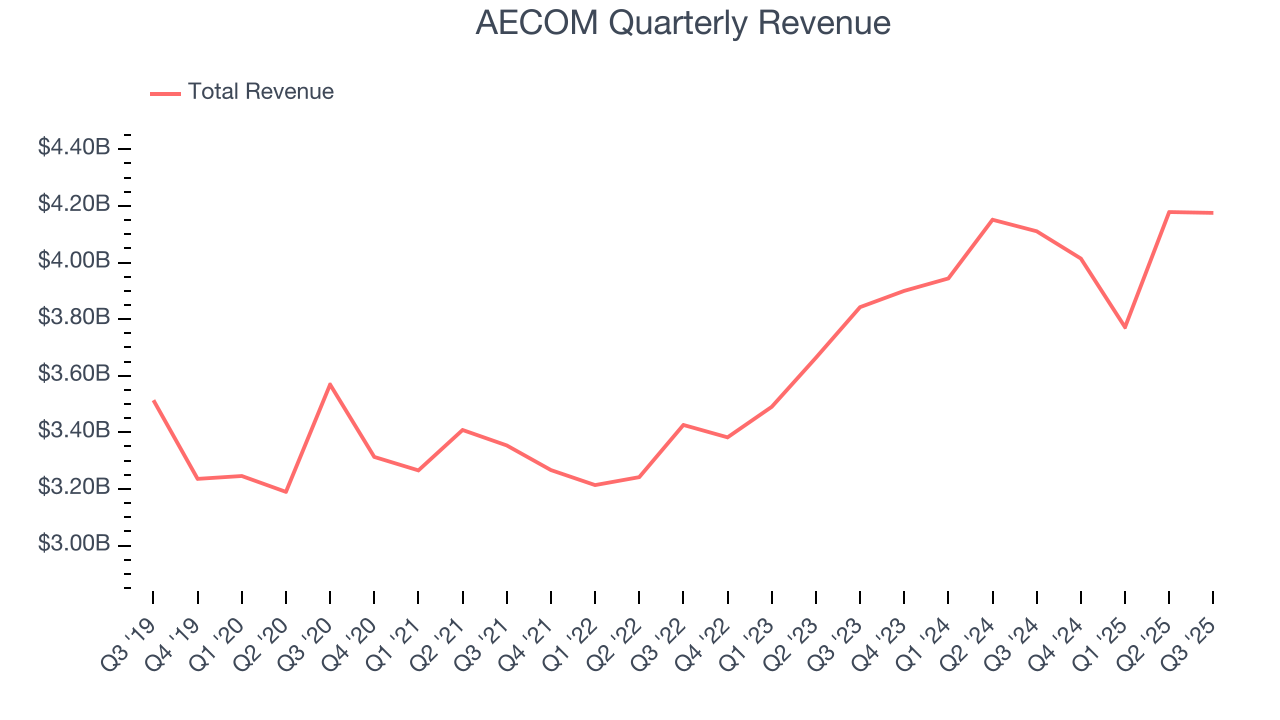
We at StockStory place the most emphasis on long-term growth, but within industrials, a half-decade historical view may miss cycles, industry trends, or a company capitalizing on catalysts such as a new contract win or a successful product line. AECOM’s annualized revenue growth of 5.9% over the last two years is above its five-year trend, but we were still disappointed by the results. 
We can better understand the company’s revenue dynamics by analyzing its backlog, or the value of its outstanding orders that have not yet been executed or delivered. AECOM’s backlog reached $24.83 billion in the latest quarter and averaged 2.7% year-on-year declines over the last two years. Because this number is lower than its revenue growth, we can see the company hasn’t secured enough new orders to maintain its growth rate in the future. 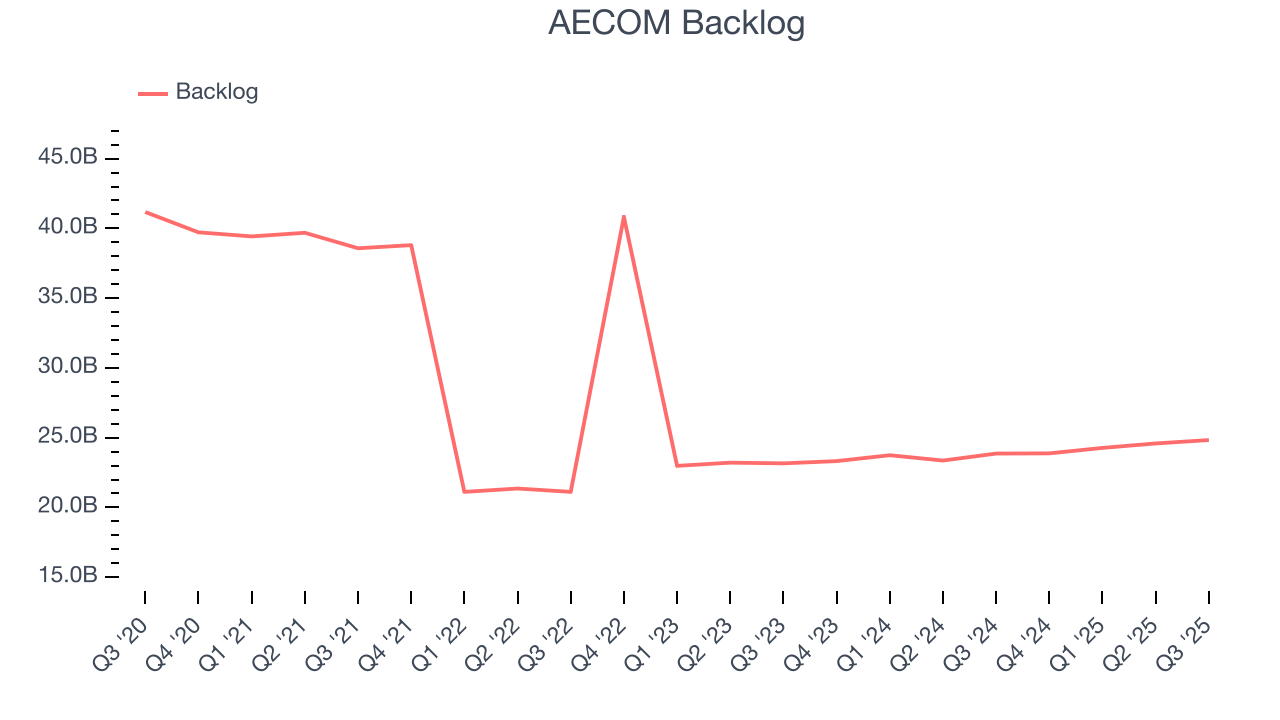
This quarter, AECOM’s revenue grew by 1.6% year on year to $4.18 billion, falling short of Wall Street’s estimates.
Looking ahead, sell-side analysts expect revenue to grow 6.4% over the next 12 months, similar to its two-year rate. This projection is underwhelming and indicates its newer products and services will not accelerate its top-line performance yet.
6. Operating Margin
AECOM was profitable over the last five years but held back by its large cost base. Its average operating margin of 4.7% was weak for an industrials business.
On the plus side, AECOM’s operating margin rose by 1.6 percentage points over the last five years, as its sales growth gave it operating leverage.
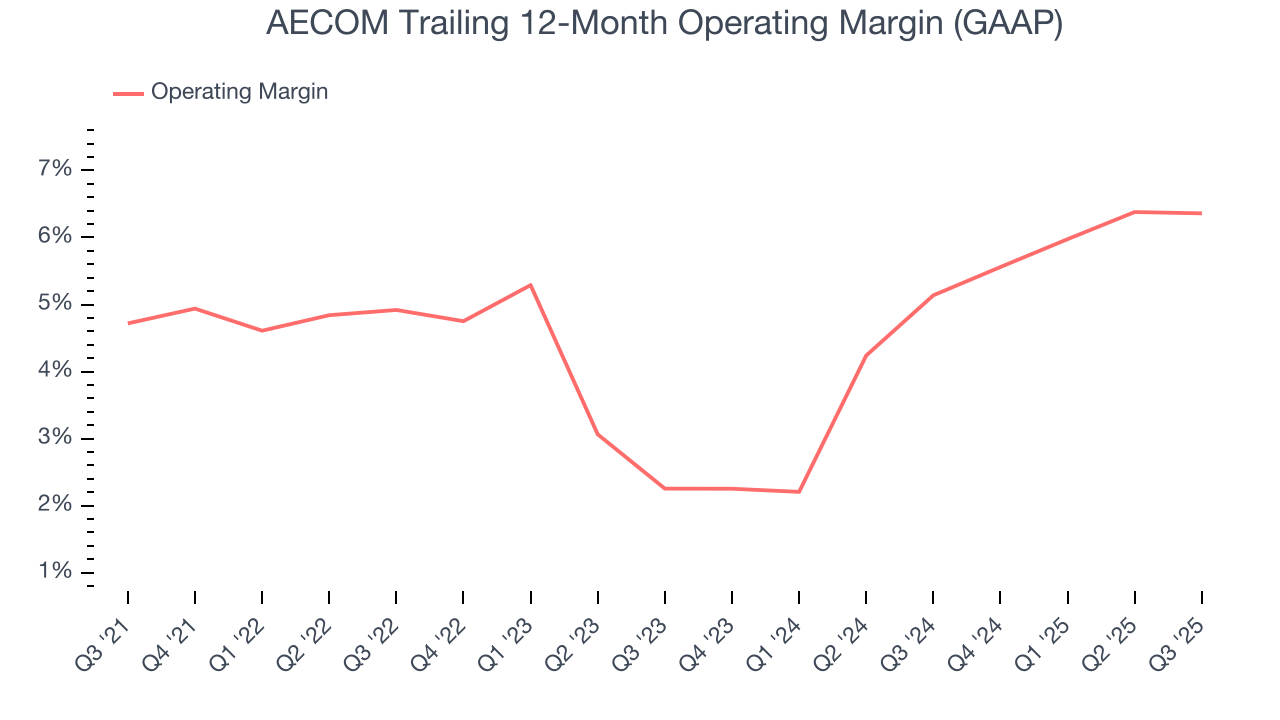
This quarter, AECOM generated an operating margin profit margin of 5.7%, in line with the same quarter last year. This indicates the company’s overall cost structure has been relatively stable.
7. Earnings Per Share
Revenue trends explain a company’s historical growth, but the long-term change in earnings per share (EPS) points to the profitability of that growth – for example, a company could inflate its sales through excessive spending on advertising and promotions.
AECOM’s EPS grew at an astounding 19.5% compounded annual growth rate over the last five years, higher than its 4% annualized revenue growth. This tells us the company became more profitable on a per-share basis as it expanded.
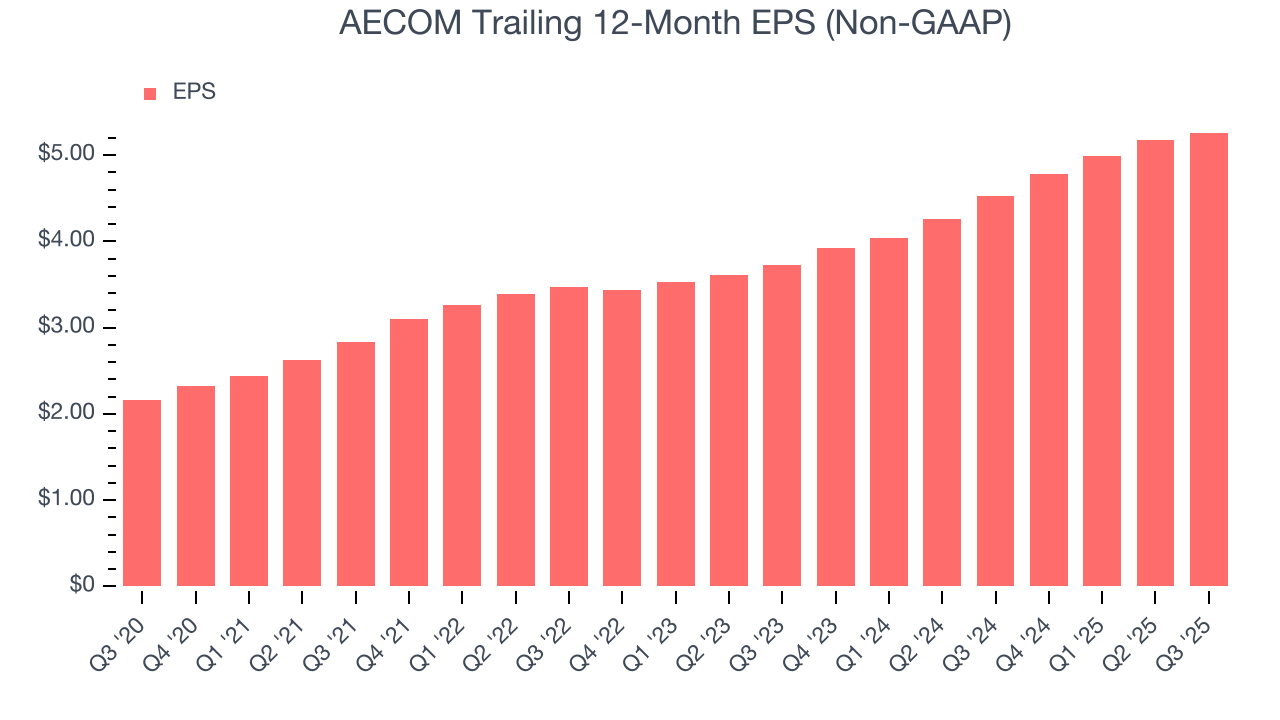
We can take a deeper look into AECOM’s earnings to better understand the drivers of its performance. As we mentioned earlier, AECOM’s operating margin was flat this quarter but expanded by 1.6 percentage points over the last five years. On top of that, its share count shrank by 16.6%. These are positive signs for shareholders because improving profitability and share buybacks turbocharge EPS growth relative to revenue growth. 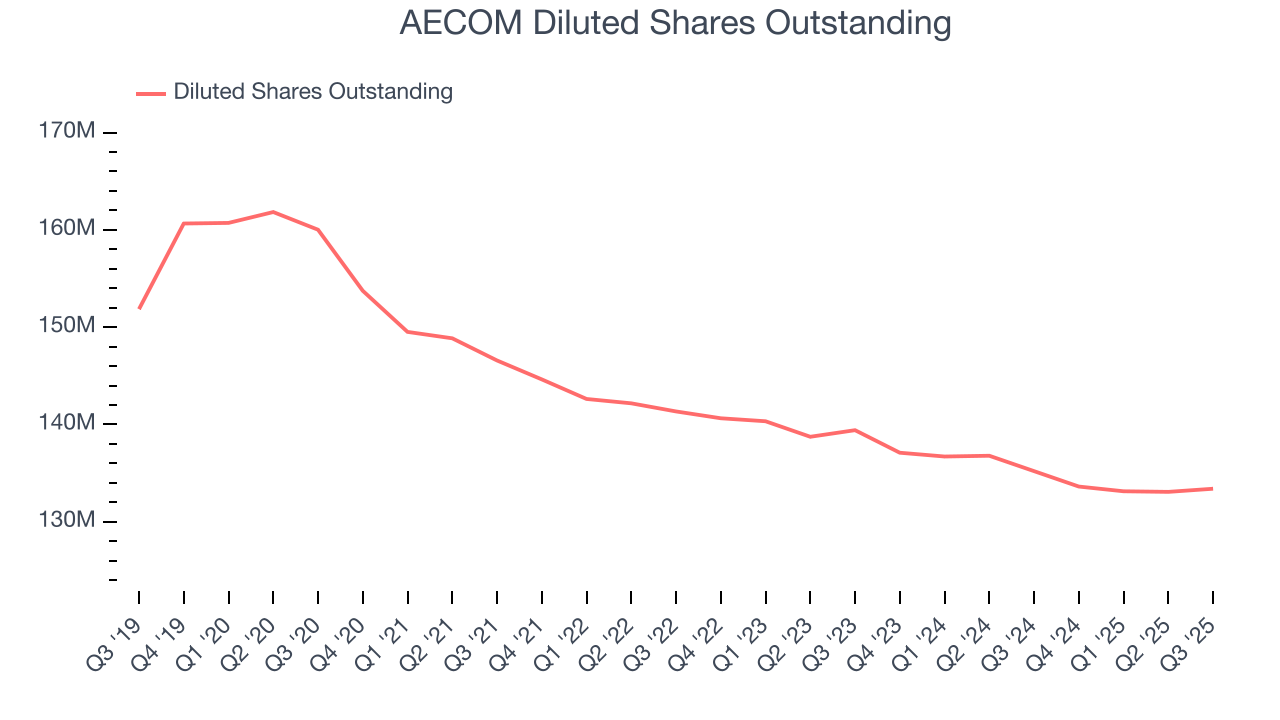
Like with revenue, we analyze EPS over a shorter period to see if we are missing a change in the business.
For AECOM, its two-year annual EPS growth of 18.8% is similar to its five-year trend, implying strong and stable earnings power.
In Q3, AECOM reported adjusted EPS of $1.36, up from $1.27 in the same quarter last year. This print beat analysts’ estimates by 1.7%. Over the next 12 months, Wall Street expects AECOM’s full-year EPS of $5.26 to grow 7.8%.
8. Cash Is King
Although earnings are undoubtedly valuable for assessing company performance, we believe cash is king because you can’t use accounting profits to pay the bills.
AECOM has shown weak cash profitability over the last five years, giving the company limited opportunities to return capital to shareholders. Its free cash flow margin averaged 4.3%, subpar for an industrials business.
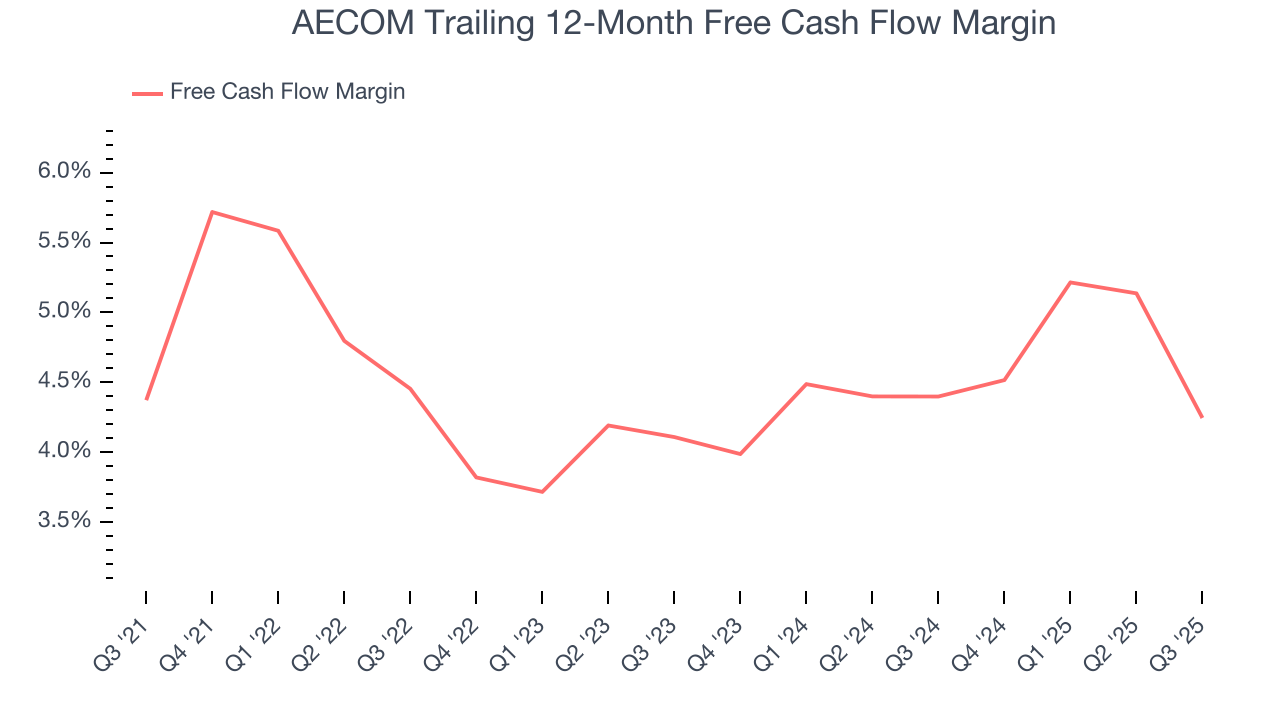
AECOM’s free cash flow clocked in at $134.1 million in Q3, equivalent to a 3.2% margin. The company’s cash profitability regressed as it was 3.5 percentage points lower than in the same quarter last year, prompting us to pay closer attention. Short-term fluctuations typically aren’t a big deal because investment needs can be seasonal, but we’ll be watching to see if the trend extrapolates into future quarters.
9. Return on Invested Capital (ROIC)
EPS and free cash flow tell us whether a company was profitable while growing its revenue. But was it capital-efficient? Enter ROIC, a metric showing how much operating profit a company generates relative to the money it has raised (debt and equity).
Although AECOM hasn’t been the highest-quality company lately because of its poor top-line performance, it historically found a few growth initiatives that worked out well. Its five-year average ROIC was 14.5%, impressive for an industrials business.
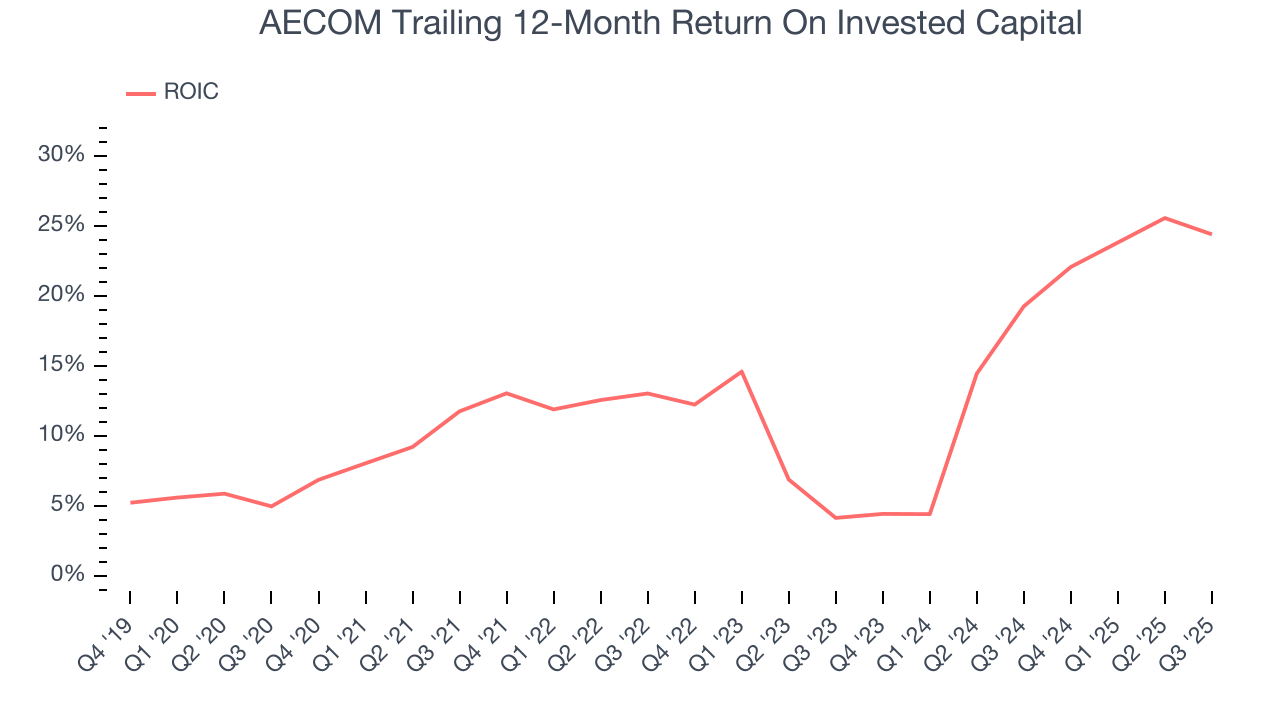
We like to invest in businesses with high returns, but the trend in a company’s ROIC is what often surprises the market and moves the stock price. Over the last few years, AECOM’s ROIC has increased. This is a good sign, and if its returns keep rising, there’s a chance it could evolve into an investable business.
10. Balance Sheet Assessment
AECOM reported $1.59 billion of cash and $2.74 billion of debt on its balance sheet in the most recent quarter. As investors in high-quality companies, we primarily focus on two things: 1) that a company’s debt level isn’t too high and 2) that its interest payments are not excessively burdening the business.
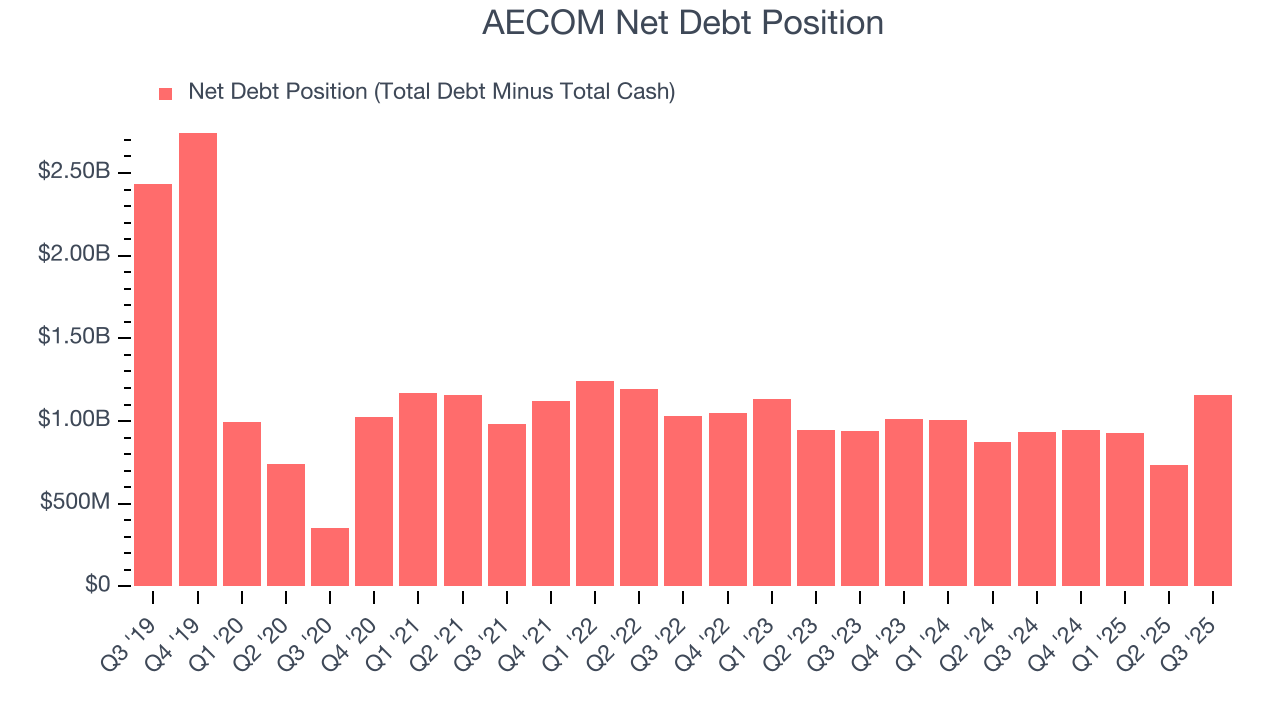
With $1.2 billion of EBITDA over the last 12 months, we view AECOM’s 1.0× net-debt-to-EBITDA ratio as safe. We also see its $39.15 million of annual interest expenses as appropriate. The company’s profits give it plenty of breathing room, allowing it to continue investing in growth initiatives.
11. Key Takeaways from AECOM’s Q3 Results
It was good to see AECOM narrowly top analysts’ EBITDA expectations this quarter. On the other hand, its revenue missed and its full-year EBITDA guidance fell slightly short of Wall Street’s estimates. Overall, this was a weaker quarter. Investors will hear much more later today during the company's Analyst Day. The stock remained flat at $132.43 immediately after reporting.
12. Is Now The Time To Buy AECOM?
Updated: December 5, 2025 at 10:27 PM EST
A common mistake we notice when investors are deciding whether to buy a stock or not is that they simply look at the latest earnings results. Business quality and valuation matter more, so we urge you to understand these dynamics as well.
AECOM isn’t a terrible business, but it isn’t one of our picks. For starters, its revenue growth was uninspiring over the last five years, and analysts expect its demand to deteriorate over the next 12 months. And while its astounding EPS growth over the last five years shows its profits are trickling down to shareholders, the downside is its backlog declined. On top of that, its projected EPS for the next year is lacking.
AECOM’s P/E ratio based on the next 12 months is 20x. While this valuation is fair, the upside isn’t great compared to the potential downside. We're fairly confident there are better stocks to buy right now.
Wall Street analysts have a consensus one-year price target of $143.33 on the company (compared to the current share price of $102.45).
Although the price target is bullish, readers should exercise caution because analysts tend to be overly optimistic. The firms they work for, often big banks, have relationships with companies that extend into fundraising, M&A advisory, and other rewarding business lines. As a result, they typically hesitate to say bad things for fear they will lose out. We at StockStory do not suffer from such conflicts of interest, so we’ll always tell it like it is.



